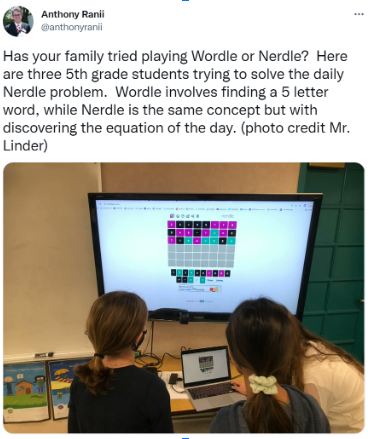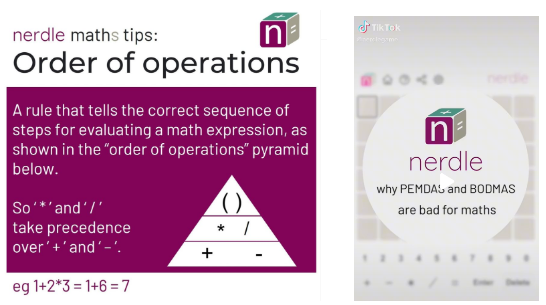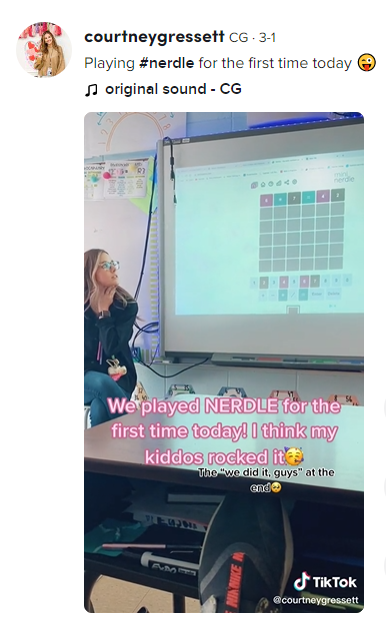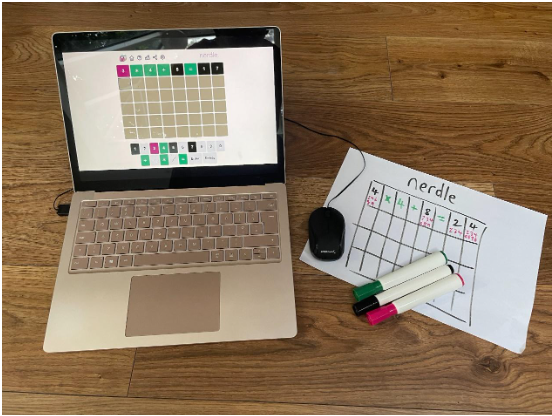Firstly, I should make it clear that I am not a teacher. Other than encouraging my two children, I have no educational experience at all. So, I am as surprised as anyone to be writing this article about inventing a math game– Nerdle — that, since January this year, has been played by millions of people around the world and loved by thousands of pupils and teachers alike.

That said, I have always loved logic problems and math games, and I am sure that a little of this rubbing off onto my children has helped encourage their passion for math too.
Nerdle is a very simple game. You have six guesses to find the eight-digit calculation that we set each day (my favorite starting guess is 3*4+5=17). That’s it! Yet, it turns out to be challenging enough to exercise the brain, accessible enough for all ages and a great way to play with a surprisingly wide range of mathematical concepts.
Having been amazed by its popularity since coming up with the idea and the name with my daughter in a London traffic jam in January, it’s worth reflecting on why its popularity at the breakfast table has also moved into the school classroom.
The beauty of simplicity and inclusivity
The simplicity of a Nerdle challenge makes it very inclusive. It is a concept that doesn’t take much time to learn, and even a harder challenge can be solved by fourth- and fifth-graders with a bit of time and teamwork.
Yet, in spite of its simplicity, Nerdles are rarely straightforward. The game introduces concepts such as commutativity (you don’t get that in Wordle!) and order of operations. Even fractions and negative numbers crop up part way through an answer on occasion. As each day’s challenge is a surprise, players often confront these concepts unexpectedly, but that’s part of the fun.
We love the fact that, out of nowhere, we’re teaching thousands of people concepts like order of operations with our simple game. We’ve even created some support articles and videos as a result.
Common Nerdle stumbling blocks
Stumbling blocks can occur in many places, just because some Nerdles are harder than others. But we’ve found that three things can really trip people up:

- Division. We see the average time to solve jump up on any day that includes a division — partly because division sums are less familiar and less practiced. But also because, with an eight-digit Nerdle, you can have a three-digit number divided by a two-digit number. The hardest multiplication result you can have is two digits by one digit.
- Order. Order of operations (the principle that, for example, multiplication takes precedence over addition, so 1+2*3=7 and not 9) triggers more confusion and more emails than anything else. There are two issues here. Firstly, some players don’t know or have forgotten about order of operations. But the more challenging one is players who believe multiplication takes precedence over division (it doesn’t; they have equal status) because they’ve learned an unhelpful mnemonic at school, such as PEMDAS or BODMAS.
- Implied negatives or fractions. A Nerdle answer is never negative or a non-integer. But occasionally you’ll find a negative number or a fraction partway through. For example, 1-7+9=3 or 1/3*6=2. These are also tricky stumbling blocks that some players struggle with.
The feel-good factor
A Nerdle challenge looks tricky, but most players can solve each one with a little mental math, possibly pen and paper, and occasionally a calculator. We’ve seen videos of classes roaring in delight when they solve a puzzle as a team!
But our favorite emails are from people who tell us that Nerdle has taught them that they actually can do math and that it’s not as scary as they thought. That feel-good factor when you solve a puzzle is a big part of the game’s popularity, we are sure.
Tweaks at teachers’ requests

We were very lucky that the first version of Nerdle had exactly the right level of difficulty to boost its popularity and help it go viral. But we have also tried to adapt the game for specific audiences. Mini Nerdle (six tiles instead of eight) was created based on requests from teachers for a game aimed at younger students. And Create.Nerdlegame.com enables teachers to set challenges around specific concepts, such as times tables. Of course, all of this is free. These adaptations have been popular so far, and we hope will improve the game’s longevity in school.
We believe Nerdle has become a magic ingredient for schools because it combines fun and education in equal measure. Ashleigh, a third-grade teacher, sums it up perfectly on her blog post “Teaching students to play Nerdle” blog post: “My students and I agree on this one! Typically, they favor games that offer a lot of fun but little educational value, while I prefer games that are heavy on content. This provides both.”
Hopefully, we can keep both pupils and teachers on our side for a long time to come. And if any math teachers would like to help us develop some ideas for future games with us, we’d really love to connect.
Richard Mann is the founder of Nerdle, the daily math game inspired by Wordle and launched in January 2022. He is CEO of Dragonfly AI, a UK-based AI marketing technology company, and the father of two keen mathematicians — Imogen, 14, and Alex, 17 — who helped with the game’s design and development. Reach out to Mann via Twitter or LinkedIn.
_______________________________
Subscribe to SmartBrief’s FREE email newsletter to see the latest hot topics on EdTech. It’s among SmartBrief’s more than 250 industry-focused newsletters.
